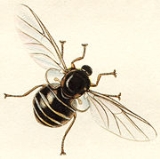
Acroceridae
Encyclopedia
Acroceridae is a small family of odd looking flies most closely related to Nemestrinidae
. There are about 520 species in 50 genera. They are characterized by a humpbacked appearance and a small head, sometimes with a long proboscis for nectar. As such, acrocerids are commonly known as small-headed flies or hunchback-flies. Many are bee or wasp mimics. Their eyes are often holoptic
; their heads seem to be composed primarily of ommatidia. They are cosmopolitan in distribution but rarely observed in most places; the majority of the over 500 species are known from fewer than 10 specimens. They are found most commonly in semi-arid tropical locations.
All small headed flies are parasitoid
s of spiders. They are most commonly collected when a spider from the field is brought into captivity. The adults do not seek out their hosts; instead the first instar larvae is a planidium
that seeks out spiders. When a spider contacts an acrocerid planidium, the larva grabs hold of the spider, crawls up the spider's legs to its body, and forces its way through the body wall, often lodging near the book lung
, where it may remain for years before completing its development. Some obsolete names for Acroceridae include "Cyrtidae" and "Oncodidae".
Nemestrinidae
Nemestrinidae, or tangle-veined flies is a family of flies in the superfamily Nemestrinoidea, closely related to Acroceridae. The family is small but distributed worldwide, with about 300 species in 34 genera. Larvae are endoparasitoids of either grasshoppers or scarab beetles...
. There are about 520 species in 50 genera. They are characterized by a humpbacked appearance and a small head, sometimes with a long proboscis for nectar. As such, acrocerids are commonly known as small-headed flies or hunchback-flies. Many are bee or wasp mimics. Their eyes are often holoptic
Holoptic
Holoptic refers to the way the eyes of a dipteran meet along the dorsal length of its head. Holoptic eyes are typical of several diptera males, in particular the Syrphoidea ....
; their heads seem to be composed primarily of ommatidia. They are cosmopolitan in distribution but rarely observed in most places; the majority of the over 500 species are known from fewer than 10 specimens. They are found most commonly in semi-arid tropical locations.
All small headed flies are parasitoid
Parasitoid
A parasitoid is an organism that spends a significant portion of its life history attached to or within a single host organism in a relationship that is in essence parasitic; unlike a true parasite, however, it ultimately sterilises or kills, and sometimes consumes, the host...
s of spiders. They are most commonly collected when a spider from the field is brought into captivity. The adults do not seek out their hosts; instead the first instar larvae is a planidium
Planidium
A planidium is a specialized type of first-instar insect larva, seen in groups that are parasitoids; they are generally flattened, highly sclerotized, have legs, are quite mobile, and sometimes have eyes...
that seeks out spiders. When a spider contacts an acrocerid planidium, the larva grabs hold of the spider, crawls up the spider's legs to its body, and forces its way through the body wall, often lodging near the book lung
Book lung
A book lung is a type of respiration organ used for atmospheric gas exchange and is found in arachnids, such as scorpions and spiders. Each of these organs is found inside a ventral abdominal cavity and connects with the surroundings through a small opening. Book lungs are not related to the lungs...
, where it may remain for years before completing its development. Some obsolete names for Acroceridae include "Cyrtidae" and "Oncodidae".
Species lists
- Palaearctic
- Nearctic
- Japan
- Australian/Oceanian
- List of soldierflies and allies of Great Britain
External links
- http://delta-intkey.com/britin/dip/www/acroceri.htm - illustrations
- http://www.acroceridae.org - Yahoo group includes preliminary bibliography
- http://www.diptera.info/photogallery.php?album_id=59 Images at Diptera.info
- http://bugguide.net/node/view/7016/bgpage Images at BugGuide

